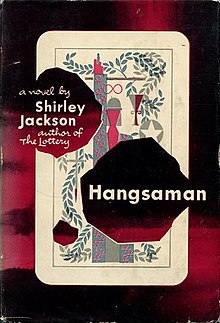Hangsaman
 Cover of first edition | |
| Author | Shirley Jackson |
|---|---|
| Language | English |
| Genre | Speculative fiction | Gothic fiction |
| Publisher | Farrar, Straus and Young |
Publication date | 1951 |
| Publication place | United States |
| Pages | 191 |
| ISBN | 978-0143107040 current edition, published by Penguin |
| Preceded by | 'The Road Through the Wall |
| Followed by | 'The Lottery and Other Stories |
Hangsaman is a 1951 gothic novel by American author Shirley Jackson. The second of Jackson's published novels, Hangsaman is a bildungsroman centering on lonely college freshman Natalie Waite, who descends into madness after enrolling in a liberal arts college.[1]
The novel takes its title from an old folk ballad. The official publisher's description of Hangsaman says the novel is “loosely based on the real-life disappearance of a Bennington College sophomore in 1946," referencing the case of Paula Jean Welden.[2] At the time, Jackson was living in Bennington, Vermont, as her husband, Stanley Edgar Hyman, was employed at Bennington College, where Welden had been a student.[1] However, Ruth Franklin's research for her 2016 biography of Jackson found no evidence the novel was inspired by Welden's disappearance.[3] Jackson's text mixes satire with psychological elements as her protagonist spends half her time in an imaginary world.[4]
Plot summary
Hangsaman tells the story of Natalie Waite, whose longing to move away from an oppressive home environment sees her attend a liberal arts school similar to Bennington College.[1]
References in other media
The 2020 film Shirley is a fictionalized account of the time in which Jackson was writing Hangsaman, depicting the novel's creation as being inspired both by the Welden disappearance and the life of a fictional boarder in the home of Jackson and her husband Stanley Hyman.[5]
References
- ^ a b c "Shirley Jackson's Horror Novel 'Hangsaman' Was Inspired By A Real-Life Disappearance". Bustle. Retrieved 2019-10-31.
- ^ "Shirley Jackson's Horror Novel 'Hangsaman' Was Inspired By A Real-Life Disappearance". Bustle. Retrieved 2020-07-12.
- ^ "What 'Shirley' gets very wrong about Shirley Jackson". Los Angeles Times. 2020-06-12. Retrieved 2020-07-12.
- ^ Parks, John G. (1984). "Chambers of Yearning: Shirley Jackson's Use of the Gothic". Twentieth Century Literature. 30 (1): 15–29. doi:10.2307/441187. ISSN 0041-462X. JSTOR 441187.
- ^ Sims, David (2020-06-08). "'Shirley' Is an Unconventional Biopic About a Horror Master". The Atlantic. Retrieved 2020-07-12.
